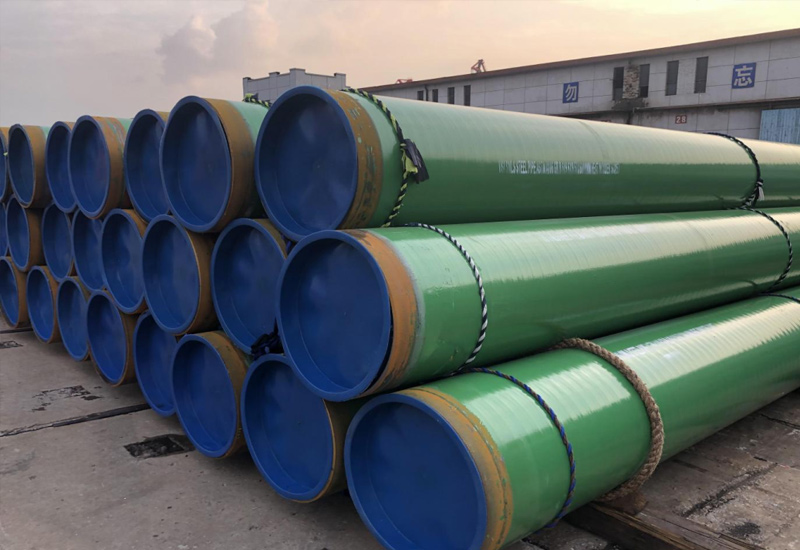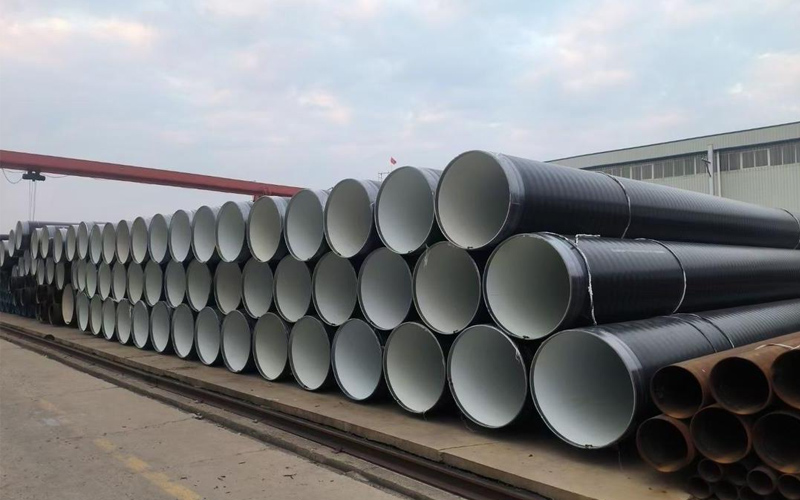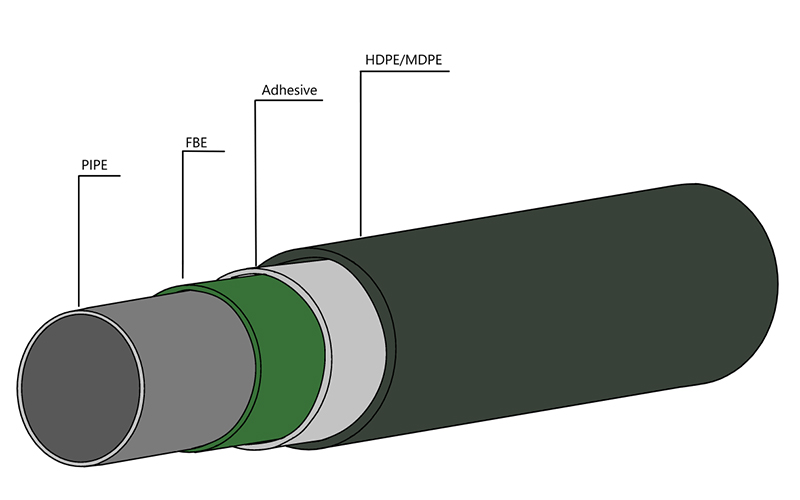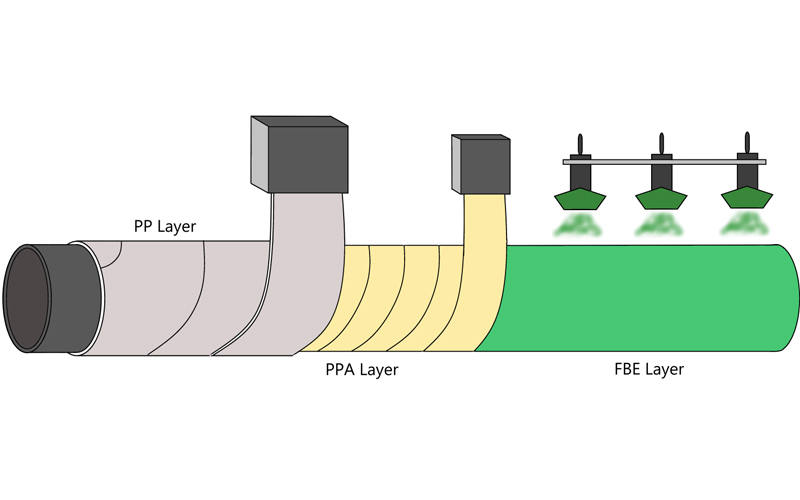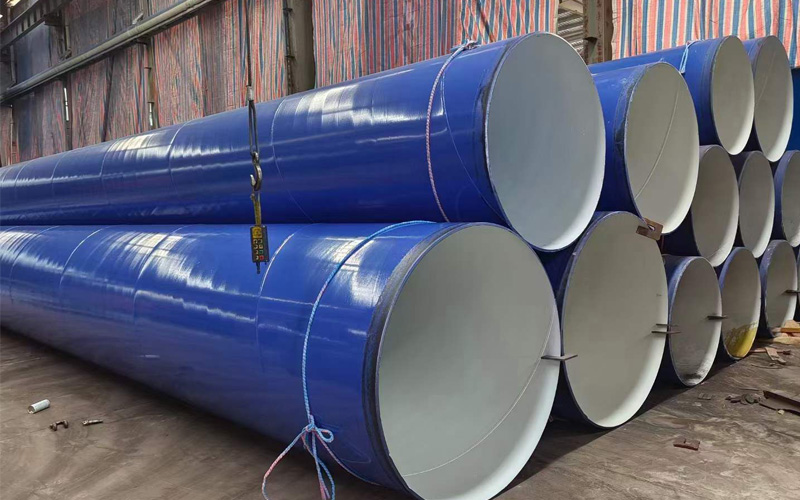How LSAW/SSAW Steel Pipes Ensure Safe & Durable Drinking Water Pipelines
In the UK, the municipal water piping supply systems have extremely high requirements for the pipeline safety, ensuring the water quality remains uncontaminated and the system operates stably to safeguard the public water safety. Among these, the AWWAC213 standard plays a crucial role, strictly the regulating various pipeline-related indicators and it could provide the important guidelines for the safe operation of the water supply systems. Among the various pipeline materials, the carbon steel pipes (LSAW/SSAW) stand out for their exceptional strength, corrosion resistance, and the excellent sealing performance, making them the mainstream portable water pipe for meeting the municipal water supply requirements. They are widely applied in the various water supply projects, providing a robust foundation for the stable operation of the UK’s water supply system.
Understanding UK’s AWWAC213: The Gold Standard for Drinking Water Safety
Within the UK’s stringent municipal water supply system standards framework, AWWA C213 is built around the core principle of the materials posing no risk of the drinking water contamination. Carbon steel pipes (LSAW/SSAW) have undergone the systematic technological upgrades to become the only mainstream pipe material capable of fully meeting the complex requirements of this standard. Their compliance pathway demonstrates a deep integration of process innovation and the standard criteria:
I. Structural Safety Assurance of the Material Base
From the dense city grids to cross-country water transmission line, steel pipes deliver scalable solutions for municipal water piping.LSAW and SSAW steel pipes achieve the structural reinforcement through different forming processes: the former uses the UOE forming the technology, featuring the short weld lengths and uniform stress distribution, making it suitable for the high-pressure water supply scenarios; the latter enhances the impact resistance through spiral weld design, particularly suitable for the areas with geological subsidence. Both the processes are certified to API 5L standards, with a yield strength of ≥355 MPa, ensuring the structural stability over a 50-year design life and providing a reliable substrate for the inner lining coating.
II. Precise Adaptation of Lining Coating Technology
To address the chemical migration limits specified in AWWWA C213 , carbon steel pipes employ a dual-layer protective system:
1. Base Inert Layer: The inner wall is the first coated with a 150–300 μm thick cement mortar lining (certified to ISO 7085 standards). Its alkaline environment with a pH of 12–13 forms a natural barrier to prevent the leaching of the metal ions; the microporous structure (porosity 18–22%) adsorbs the free chlorine in water, avoiding the oxidation reactions.
2. Reinforced isolation layer: In the areas with the complex water quality , an epoxy resin coating is applied using a solvent-free electrostatic spraying the process to form a dense membrane layer with a thickness of 0.3–0.5 mm.

III. Technical Implementation of the Full-Cycle Certification System
The compliance of the carbon steel pipes is achieved through a three-tier verification system:
• Raw material traceability: The steel production processes comply with the EN 10204 certification, with the sulphur and phosphorus content controlled below 0.025%, minimising the risk of impurity migration from the source.
• Process control: Sandblasting for the rust removal (Sa2.5 standard) is conducted prior to the lining construction, and the temperature curves are monitored in the real-time during coating curing to ensure the film quality.
LSAW & SSAW Steel Pipes: Engineered for Water Distribution
1.As critical water distribution pipe components, LSAW pipes offer unmatched strength for large diameter water main installations.LSAW steel pipes produced using the UOE forming process are manufactured through single-seam welding to form large-diameter pipe bodies , with the weld lengths accounting for only 1/3 to 1/2 of the pipe circumference. This reduces the weld stress concentration points by 70% compared to the traditional multi-seam joint structures. The welds undergo 100% ultrasonic (UT) + radiographic (RT) dual inspection, with a pressure-bearing capacity exceeding 16 MPa, significantly outperforming ductile iron pipes of the same wall thickness (maximum pressure-bearing capacity of 10 MPa). Even when subjected to sudden water hammer impacts (instantaneous pressure peaks reaching 1.8 times the design pressure), the welds remain crack-free, ensuring emergency water supply safety for an area with a population of millions.
2.SSAW steel pipes are uniformly distributed at the angles of 30° to 45° around the pipe body, forming a circumferential + axial dual-stress-bearing the structure. SSAW steel pipes successfully withstand the annual freeze-thaw settlement of 0.5 to 1.2 mm, absorbing ground the displacement energy through the spiral deformation of the welds, thereby avoiding the risk of weld tearing associated with the traditional straight-seam pipes. Its flexible coiled pipe transportation design (with a single coil length of up to 200 metres) improves the construction efficiency by 60% in the mountainous areas with the complex terrain, reduces the number of weld joints by 35%, and minimises the leakage risks from the construction source.

Achieving Corrosion Resistance: The Key to Longevity
For LSAW and SSAW steel pipe, a reliable internal and external protective layer must be constructed for the drinking water pipeline.
1. Epoxy Resin Powder Coating (FBE)
For the hard water environments (calcium and magnesium ion concentrations > 200 ppm) and acidic soil penetration areas, both LSAW and SSAW pipes are coated with a 0.3–0.5 mm thick epoxy resin coating (WRAS-certified product) using a solvent-free electrostatic spraying process. The epoxy groups in the coating’s molecular chains form the covalent bonds with the iron oxides on the steel pipe surface. After a 1,000-hour immersion test according to BS EN 13130-1 standards, the total volatile organic compounds (VOCs) in the leachate were <0.001 mg/L, far below the EU Drinking Water Directive (98/83/EC) limit of 0.1 mg/L.
The smoothness of the coating surface (Ra ≤ 10 μm) creates a plastic-like water-carrying interface. In a 10-year operational monitoring study by London Thames Water on two types of pipes, the scaling rate was <0.02 mm/year, only one-fifth of the untreated steel pipes. When combined with a cathodic protection system, it could achieve the zero corrosion penetration on the inner walls of LSAW and SSAW pipes.
2.3PE composite coating
Both LSAW and SSAW pipes adopt a three-layer polyethylene (3PE) external corrosion protection system : The first layer, 50–100 μm of epoxy powder (FBE),it could provide chemically inert base. The intermediate layer, 200–400 μm of adhesive, facilitates polar transition. The outer layer, 2–3 mm of the low-density polyethylene (LDPE), forms a mechanical protective layer. In the soil along the North Sea coast with a salt content of 1% and a moisture content of 25%, after 5,000 hours of the salt spray testing (NSS method), the corrosion spread radius at the coating damage site was <2 mm, and the resistance to cathodic delamination was below 10 mm (far exceeding the standard requirement of 15 mm).

3.System-wide compliance verification and lifecycle optimisation
Whether it is LSAW or SSAW steel pipes, the corrosion resistant water pipe require to meets the dual inertia requirements of the AWWWA C213 standard. The lifecycle cost of the LSAW and SSAW steel pipes using a full corrosion protection system is 22% lower than the ductile iron pipes, primarily due to:
· The inner lining reduces pipeline cleaning frequency (from every 5 years for traditional steel pipes to every 15 years)
· The outer coating extends the cathodic protection spacing from 500 metres to 1,500 metres, and a 30% reduction in operational and the maintenance costs. This technical advantage has made it the only pipe material solution to pass the 100-year lifecycle assessment.
Analysing the Long-Term Value of Certified Carbon Steel Pipes
(1) Lifecycle Cost Advantage: Building the Economically Efficient Water Infrastructure
AWWWAC213-certified LSAW and SSAW carbon steel pipes could achieve the design lifespan of over 50 years through the structural reinforcement and the corrosion protection technology, extending the replacement cycle by 2-3 times compared to the traditional pipes. While the initial investment for carbon steel pipe networks is 12% higher than ductile iron pipes, the LCC is reduced by 28% due to zero mid-term major repairs and a 66% reduction in pipeline cleaning frequency. Additionally, its superior pressure-bearing performance reduces the need for pump stations, lowering energy consumption by 18% compared to traditional solutions, achieving cost optimisation across investment, operations, and energy consumption.
(2) Sustainable value: a green choice
The 100% recyclable nature of the carbon steel pipes makes them a model for the circular economy. After dismantling, the steel is remelted in an electric arc furnace to produce the new pipes compliant with EN 10204 standards, reducing the carbon footprint by 75% compared to the virgin steel production. It could combine with lining coating technology to achieve the zero leakage rates , this solution reduces the water resource losses by 15-20% annually.It’s a commitment to the public health and resilient water distribution pipe networks.
Get Your Custom Steel Pipe Quote Today!
Provide us with your project details (like application, specifications, quantity). Our experienced team will respond with a tailored solution and competitive quote within 24 business hours.
Related Articles
ASTM A53 vs. API 5L: A Guide to Selection and Application
Introduction:Technology differences determine success or failure, and selection needs to be “precise”
Steel Density Analysis: Core Differences between Mild and Medium Carbon Steels and Industrial Applications
3LPE coated steel pipe: a solid barrier in the field of industrial corrosion protection
3LPP coated pipe: anti-corrosion guard in high temperature and high pressure environment
FBE steel pipe: the technological armor of the steel defense line
HOT TAGS
latest posts
- ASTM A53 vs. API 5L: A Guide to Selection and Application
- Cracking the Code: What Makes SSAW Spiral Steel Pipes the Engineer’s Top Pick Worldwide
- What is ASTM A252 pipe? Engineering basic solution.
- A Concise Guide to EN 10217: European Standard for Pressure Welded Tubes
- The Hydrostatic Test: Why It’s the Final Defense for API 5L Pipe Integrity




